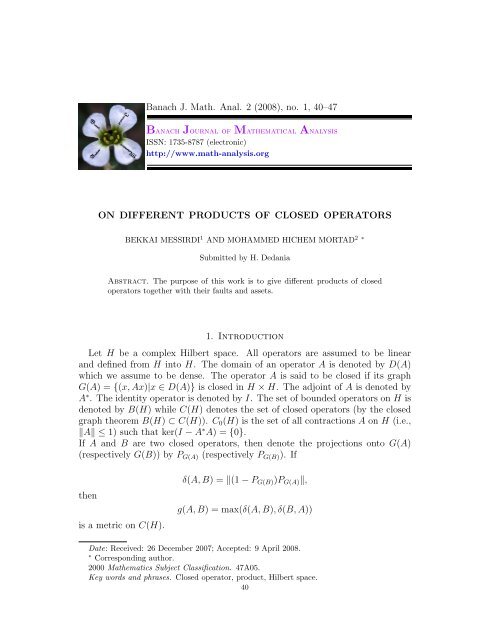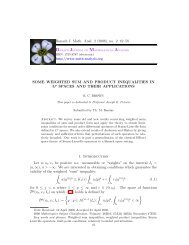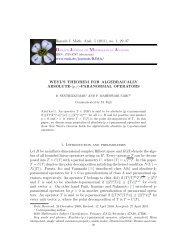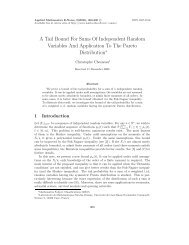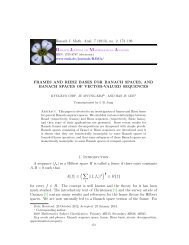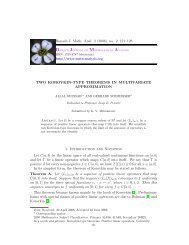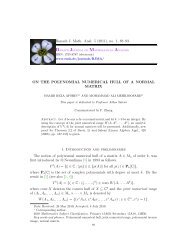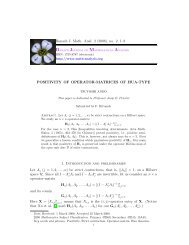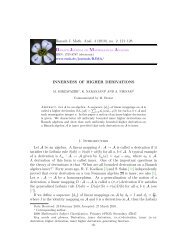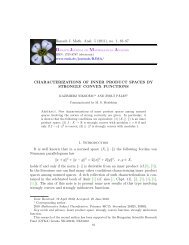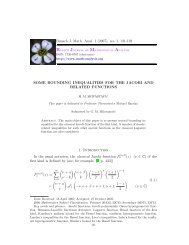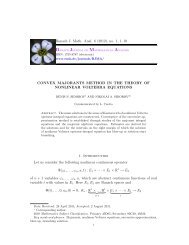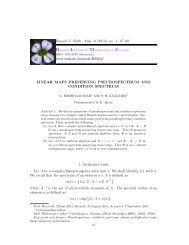On different products of closed operators
On different products of closed operators
On different products of closed operators
Create successful ePaper yourself
Turn your PDF publications into a flip-book with our unique Google optimized e-Paper software.
42 B. MESSIRDI, M.H. MORTAD(where Ω is some complex function, see [1]) on the domain D(A) = (Ω − 1)H 2 (S)where H 2 (S) denotes the Hardy space on the unit circle S (see [16]).This example can further be exploited to show another deficiency <strong>of</strong> this productas regards to the distributive law. For example, the inclusion A(B + C) ⊃AB + AC may be strict. For if it were true then one would have on the one handD(A(A − A)) = D(A) and on the other hand D(A 2 − A 2 ) = D(A 2 ) = {0}.Last but not least, the operator AB can just not make any sense if D(A) ∩Ran(B) = {0} (“Chern<strong>of</strong>f” again is an example <strong>of</strong> that).Now if we talk about adjoints, then the results are not better. For instance,the adjoint <strong>of</strong> AB if both <strong>operators</strong> are unbounded does not equal to B ∗ A ∗ (oneonly has A ∗ B ∗ ⊂ (BA) ∗ and equality if B is bounded in this order).2. The Dixmier ProductJ. Dixmier [4] gave another definition <strong>of</strong> a product. For the sake <strong>of</strong> convenience<strong>of</strong> the reader we recall it and the noteworthy results he obtained.Definition 2.1. The product A · B <strong>of</strong> two <strong>operators</strong> A and B is defined in thefollowing way. We say that f ∈ D(A · B) and g := A · Bf if there exist twosequences, (f n ) n in D(B) and (g n ) n in RanA, f n → f and g n → g, such thatA −1 g n − Bf n −→ 0 (for some well-chosen A −1 g n and Bf n ).By adopting this definition he obtainedTheorem I. The operator A · B is <strong>closed</strong>.Theorem II. (1) The two <strong>products</strong> AB and A·B coincide if either <strong>of</strong> the followingoccurs:(a) A <strong>closed</strong> and B bounded;(b) A −1 bounded and B <strong>closed</strong>.(2) A · B coincide with the closure <strong>of</strong> AB if the roles <strong>of</strong> A and B in a) or b) areinverted.In the previous theorem, Property 1) is no longer true if A is bounded and Bis <strong>closed</strong> since in this case AB may not be <strong>closed</strong>. There is a nice example dueto A.M. Davie [3] which is as follows: on L 2 (U), where U is the strip 0 < x < 1in the (x, y) plane, let Bf(x, y) = yf(x, y) and Af(x, y) = xf(x, y). Then if f issuch that xyf(x, y) is in L 2 but yf(x, y) is not then f is in the closure <strong>of</strong> D(AB)(in the graph norm) but f is not in D(B), and whence not in D(AB).J. Dixmier also got a formula for adjoints which isTheorem III. If A and B are <strong>closed</strong> , then (AB) ∗ = B ∗ · A ∗ ; and in general,(A · B) ∗ = B ∗ A ∗ .3. The MM-ProductAs alluded to in the introduction we now give a new definition <strong>of</strong> a product <strong>of</strong>two <strong>closed</strong> <strong>operators</strong> on a Hilbert space. If A is a densely defined <strong>closed</strong> operatorin a Hilbert space with domain D(A). Then, it is known (cf. [2, 15]) that theoperator B = (1+A ∗ A) is <strong>closed</strong> (it is even self-adjoint) and has bounded inverse.
PRODUCTS OF CLOSED OPERATORS 43Its inverse, which we denote by R A , is also positive. Hence by the square rootlemma (see [15]), we know that there exists a unique positive operator C suchthat C 2 = R A . Hence, it is legitimate to consider the operatorS A = (1 + A ∗ A) − 1 2(as denoted by Labrousse–Mercier [7]).It is also known (cf. [2, 15]) that AR A is bounded as long as A is <strong>closed</strong>.Besides ranR A is equal to D(A ∗ A) and A ∗ AR A = I − R A . And for x ∈ D(A) onehas R A ∗Ax = AR A x so that (AR A ) ∗ = A ∗ R A ∗. We also have)2∀x ∈ H , ∥ 1∥(2 − R A x∥ + ‖AR A x‖ 2 = 1 4 ‖x‖2 .Hence ‖R A ‖ ≤ 1 and ‖AR A ‖ ≤ 1 2 . Another property is ker(AR A) = ker A. Nowwe give some properties <strong>of</strong> S A that will be needed.Proposition 3.1. For all x ∈ H one hasThe range <strong>of</strong> S A is ranS A = D(A).‖S A x‖ 2 + ‖AS A x‖ 2 = ‖x‖ 2 . (3.1)Pro<strong>of</strong>. From‖R A x‖ 2 + ‖AR A x‖ 2 =< x, R A x > , ∀x ∈ H,we obtain‖S A S A x‖ 2 + ‖AS A S A x‖ 2 = ‖S A x‖ 2 , ∀x ∈ H. (3.2)Hence AS A is bounded on ran(R A ) with a norm smaller than 1. Now sinceran(R A ) ⊂ ran(S A ) ⊂ D(A) is dense in D(A) with respect to the graph normand since Equation 3.2 shows that ran(S A ) is dense in D(A) then it follows thatran(S A ) = D(A).□Remark 3.2. From the last proposition one obtains ‖S A ‖ B(H) ≤ 1 and ‖AS A ‖ B(H) ≤1.Proposition 3.3. The following properties hold1) If x ∈ D(A), S A ∗Ax = AS A x,2) (AS A ) ∗ = A ∗ S A ∗,3) ker(AS A ) = ker(A).Pro<strong>of</strong>. 1) Since R A is a positive contraction, then there exists a sequence <strong>of</strong> polynomialsP n (R A ) (see [14]) such that the degree <strong>of</strong> P n (R A ) is 2 n−1 andP n (0) = 0 , P n (R A ∗)A = AP n (R A ) andSo if x ∈ D(A) thenS A ∗Ax =2) Let x ∈ D(A). Thenlim ‖P n(R A ) − S A ‖ B(H) = 0.n→+∞lim P n(R A ∗)Ax = lim AP n(R A )x = AS A x.n→+∞ n→+∞∀y ∈ H, < AS A x, y >=< S A ∗Ax, y >=< x, A ∗ S A ∗y > .Hence AS A = (A ∗ S A ∗) ∗ on D(A) and hence on all H since D(A) is dense in H.3) This property is trivial. □
44 B. MESSIRDI, M.H. MORTADDefinition 3.4 (Labrousse–Mercier [7]). Let A ∈ C(H). Then the bisecting<strong>of</strong> A is the operator à defined asà = AS A (1 + S A ) −1 .Proposition 3.5. Let A ∈ C(H). Then1) à ∈ C 0(H).2) (Ã)∗ = Ã∗ .3) Rà = I+S A.24) ÃR à = AS A2.Pro<strong>of</strong>. Let A ∈ C(H). Then‖Ã‖ B(H) ≤ ‖AS A ‖ B(H) ‖(I + S A ) −1 ‖ B(H) ≤ 1which proves 1). Then by the previous proposition, propriety 2) we have (Ã)∗ =(I + S A ) −1 A ∗ S A ∗. But if x ∈ D(A ∗ ) then A ∗ S A ∗x = S A A ∗ x and hence(A ∗ + A ∗ S A ∗)x = (A ∗ + S A A ∗ )x.SoorAccordingly,A ∗ (I + S A ∗)x = (I + S A )A ∗ x(I + S A ) −1 A ∗ x = A ∗ (I + S A ∗) −1 x.(Ã)∗ = A ∗ (I + S A ∗) −1 S A ∗ = A ∗ S A ∗(I + S A ∗) −1 = Ã∗ ,establishing 2).To prove 3) we do the followingSinceI + Ã∗ à = I + (I + S A ) −1 A ∗ S A ∗AS A (I + S A ) −1 .A ∗ S A ∗AS A = S A A ∗ AS A = S A (I + A ∗ A)S A − R A = S A R −1A S A − R A = I − R A ,thenThereforeI + Ã∗ à = I + (I + S A ) −1 (I − R A )(I + S A ) −1 .I + Ã∗ à = (I + S A ) −1 [(I + S A ) + (I − S A )(I + S A )(I + S A ) −1 ] = 2(I + S A ) −1 .ThusRà = (I + Ã∗ Ã) −1 = I + S A.2The last property is proved straightforwardly.Our approach in defining a new product is based upon the following result (alsodue to Labrousse–Mercier [7])□
Theorem 3.6. 1) If A ∈ B(H) thenPRODUCTS OF CLOSED OPERATORS 45‖Ã‖ B(H) =1 +‖A‖ B(H)√1 + ‖A‖ 2 B(H)(in particular ‖Ĩ‖ B(H) = 11+ √ 2 ). Conversely, if ‖Ã‖ B(H) < 1 then A ∈ B(H) and‖A‖ =2‖Ã‖ B(H)1 − ‖Ã‖2 B(H).2) The map F : A −→ F (A) = Ã from (C(H), g) onto (C 0(H), ‖ · ‖ B(H) ) isbijective and open.Remark 3.7. For any <strong>closed</strong> T in C 0 (H) one has(F −1 (T )) ∗ = F −1 (T ∗ ).So the definition we give in this paper is the followingDefinition 3.8. Let A, B ∈ C(H). Then we define the product • <strong>of</strong> A and B byA • B = F −1 (F (A)F (B))where F (A)F (B) is the usual product defined on H.The first result we have got is the followingTheorem 3.9. Let A, B ∈ C(H).1) if ‖F (A)F (B)‖ B(H) < 1, thenA • B = 2F (A)F (B) (1 − F (B ∗ )F (A ∗ )F (A)F (B)) −1 ,i.e., A • B is bounded on H and‖A • B‖ =2‖F (A)F (B)‖ B(H).1 − ‖F (A)F (B)‖ 2 B(H)2) If ‖F (A)F (B)‖ B(H) = 1, then A • B is an unbounded densely defined <strong>closed</strong>operator with domain D(A • B) = ran(I − F (B ∗ )F (A ∗ )F (A)F (B)).And for y = [I − F (B ∗ )F (A ∗ )F (A)F (B)]x ∈ D(A • B) we have(A • B)y = 2F (A)F (B)x.Pro<strong>of</strong>. 1) If ‖F (A)F (B)‖ B(H) < 1, then the operator (I−F (B ∗ )F (A ∗ )F (A)F (B))is invertible with bounded inverse given by the Neumann series∞∑(F (B ∗ )F (A ∗ )F (A)F (B)) n .n=0Accordingly, 2F (A)F (B)(I − F (B ∗ )F (A ∗ )F (A)F (B)) −1 ∈ B(H) and it is easyto check thatF [2F (A)F (B)(I − F (B ∗ )F (A ∗ )F (A)F (B)) −1 ] = F (A)F (B)and the B(H)-norm <strong>of</strong> A • B is easily computed.
46 B. MESSIRDI, M.H. MORTAD2) First, the operator A•B is densely defined since ran(I−F (B ∗ )F (A ∗ )F (A)F (B))is dense in H. It is also <strong>closed</strong>. For if (y n ) n is a sequence in D(A • B) whichconverges to y in H for which A • By n converges to z in H then by settingone getsx n = [I − F (B ∗ )F (A ∗ )F (A)F (B)] −1 y n and t n = R −1F (A)F (B) x n,y n = [I−F (B ∗ )F (A ∗ )F (A)F (B)]x n = (2R F (A)F (B) −I)R −1F (A)F (B) x n = (2R F (A)F (B) −I)t nwhich converges to y and(A • B)y n = 2F (A)F (B)x n = 2F (A)F (B)R F (A)F (B) t n −→ z.By virtue <strong>of</strong> Equation (3.1), (t n ) n is a Cauchy sequence that converges to x in HwithandR F (A)F (B) x = ω , y = [I − F (B ∗ )F (A ∗ )F (A)F (B)]ω ∈ D(A • B)z = 2F (A)F (B)ω = (A • B)y.Now one easily shows that F (A•B) = F (A)F (B) and finally A•B is unboundedsince D(A • B) is strictly contained in H.To show this assume D(A • B) = H then (I − F (B ∗ )F (A ∗ )F (A)F (B)) wouldthen be invertible which would in turn lead to ‖F (A)F (B)‖ B(H) < 1 which is acontradiction.□Remark 3.10. The law • is not commutative (unless à and ˜B commute!). It is,however, associative but it does not have an identity element. Nevertheless, thislaw has a fundamental property about adjoints that is no shared by the usualproduct in the unbounded case.We haveProposition 3.11. We have (B • A) ∗ = A ∗ • B ∗ .Pro<strong>of</strong>. We haveHence, by Remark 3.7, we get(A • B) ∗ = ( F −1 (F (A)F (B)) ) ∗.(A • B) ∗ = F −1 [(F (A)F (B)) ∗ ] .Then since F (A) and F (B) are bounded and by Proposition 3 we deduce that(A • B) ∗ = F −1 [F (B ∗ )F (A ∗ )] = B ∗ • A ∗ .The last result in this paper is again a property that is not always true forarbitrary <strong>closed</strong> <strong>operators</strong> in the usual product.Corollary 3.12. If either A or B is in B(H), then so is A • B.Pro<strong>of</strong>. We only prove the result for A. If A ∈ B(H), then ‖F (A)‖ B(H) < 1 andhence ‖F (A)F (B)‖ B(H) < 1. Thus A • B ∈ B(H).□□
PRODUCTS OF CLOSED OPERATORS 47References1. P.R. Chern<strong>of</strong>f, A semibounded <strong>closed</strong> symmetric operator whose square has trivial domain,Proc. Amer. Math. Soc., 89/2 (1983), 289–290.2. J.B. Conway, A Course in Functional Analysis, Springer, 1990.3. A.M. Davie (The University <strong>of</strong> Edinburgh), Personal Communication.4. J. Dixmier, L’adjoint du Produit de Deux Opérateurs Fermés, Annales de la faculté dessciences de Toulouse 4e Série, 11(1947), 101–106.5. M. Hasanov, <strong>On</strong> local invertible <strong>operators</strong> in L 2 (R 1 , H), Math. Nachr., 228 (2001), 145–154.6. T. Kato, Perturbation Theory for Linear Operators, Springer, 1980.7. J.Ph. Labrousse and B. Mercier, Extension du Théorème de Brown-Douglas-Fillmore auCas des Opérateurs Non-bornés, J. Operator Theory, 24 (1990), 137-154.8. B. Messirdi and A. Senoussaoui, Parametrix du Problème de Cauchy C ∞ HyperboliqueMuni d’un Système d’Ordres de Leray-Volevîc, Journal for Analysis and its Applications,24/3 (2005), 581–592.9. B. Messirdi, A. Rahmani and A. Senoussaoui, Problème de Cauchy C ∞ pour des Systèmesd’Equations aux Dérivées Partielles à Caractéristiques Multiples de Multiplicité Paire, Bull.Math. Soc. Sci. Math. Roumanie, 49/97, N 4, (2006), 345–358.10. M.H. Mortad, An Application <strong>of</strong> the Putnam-Fuglede Theorem to Normal Products <strong>of</strong> SelfadjointOperators, Proc. Amer. Math. Soc., 131/10 (2003), 3135–3141.11. M. Naimark, <strong>On</strong> the Square <strong>of</strong> a Closed Symmetric Operator, Dokl. Akad. Nauk SSSR, 26(1940), 866–870; ibid. 28 (1940), 207–208.12. G. Neubauer, Homotopy Properties <strong>of</strong> Semi-Fredholm Operators in Banach Spaces, Math.Ann., 176(1968), 273–301.13. M. Reed and B. Simon, Methods <strong>of</strong> Modern Mathematical Physics, Vol. 1, Functional Analysis,Academic Press, 1972.14. F. Riesz and B. Sz.-Nagy, Leçons d’analyse Fonctionnelle, Gauthier-Villars, 1972.15. W. Rudin, Functional Analysis, McGraw–Hill, 1991.16. E.M. Stein, Harmonic Analysis, Princeton University Press, 1993.1 Département de Mathématiques, Université d’Oran (Es-senia), B.P. 1524, ElMenouar, Oran 31000, Algeria.E-mail address: bmessirdi@univ-oran.dz, bmessirdi@yahoo.fr.2 Département de Mathématiques, Université d’Oran (Es-senia), B.P. 1524, ElMenouar, Oran 31000, Algeria.E-mail address: mortad maths@yahoo.com, mortad@univ-oran.dz.


